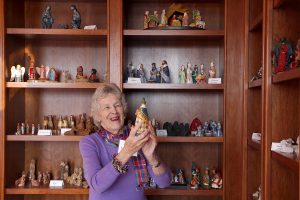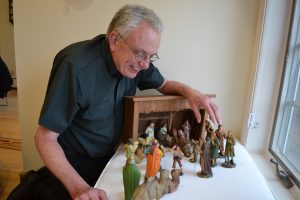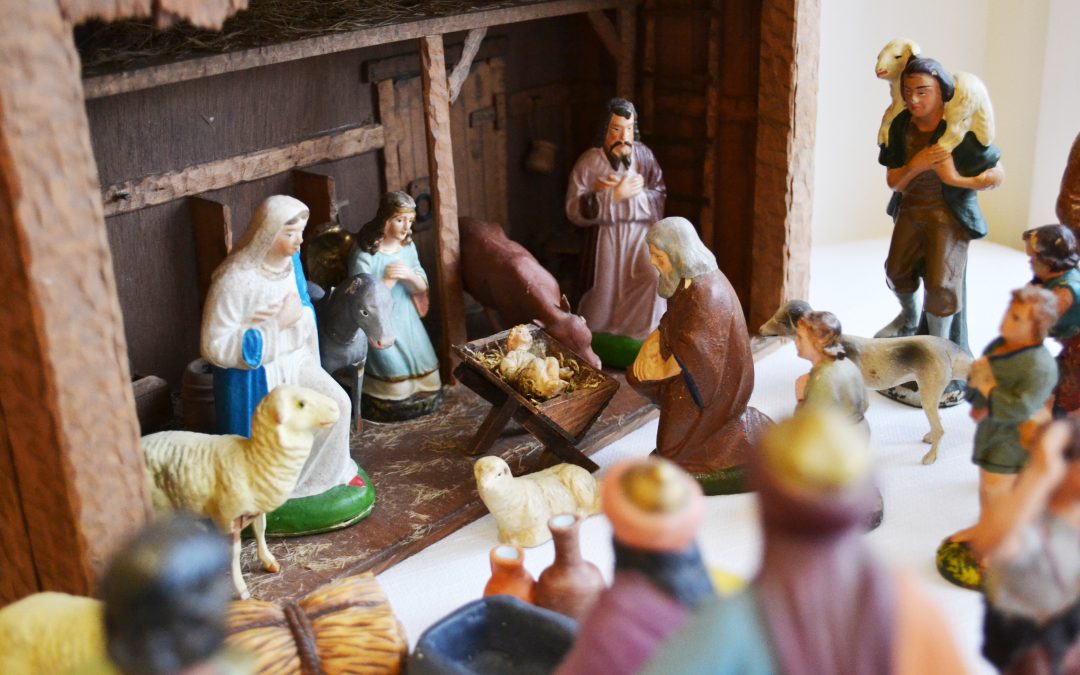By NANNETTE DRAKE OLDENBOURG
Two local crèche enthusiasts were inspired to collect by the awe they felt as children peering at Nativity scenes with the baby Jesus surrounded by adoring animals. For the Reverend Tim Goldrick, pastor at St. Patrick’s Catholic Church in Falmouth, and for Bill Hendel of West Falmouth and Florida an added bonus has been to learn about the vast variety of crèche scenes created around the world.
Father Goldrick has the nickname “Father Christmas” for good reasons. The path to that name appeared early. He was fascinated with Nativity scenes as a young boy. “In 1st grade at Christmas the pastor in my parish gave all the school children a pop-up cardboard Nativity scene. I had it for years.”
Father Goldrick recalls he then “pestered” his mother into buying a cardboard stable with plaster figures glued in place (from the Five and Ten).”

Gretchen Partridge has been arranging Bill Hendel’s crèche collection at the annual Holidays at Highfield display for many years. The crèches are from many countries, in a many styles and media.
Also in line for “pestering” was his grandfather, who let young Tim help set up the fine papier-mâché Nativity scene in their home in New Bedford starting when he was in kindergarten. The importance of the Nativity scene to his grandfather, with his Portuguese background and its traditions, was apparent.
Finally, the future priest’s fascination led him to boldly ask his grandfather if he could have the Nativity “when he was ‘done playing with it.’” He did inherit the set. “It is still my most prized crèche!” Timothy later learned that the set was made in Germany out of fine papier-mâché poured into molds. The great popularity of similar sets spurred a cottage industry in parts of Germany and Italy.
After ordination, Father Goldrick purchased his second Nativity scene while on vacation in the Azores. Following that purchase, here on Cape Cod he met a woman from Cataumet (the late Anne Austill) who had traveled internationally quite extensively with her missionary husband and had collected Nativity scenes wherever she went. That was that. “I was hooked,” Father Goldrick said.
The crèches’ appeal is multifaceted to Father Goldrick. “I have always considered the crèche to be a home-shrine, a place for quiet prayer and reflection,” he said. Through research and reading, he learned that crèches had originated as a teaching tool. He himself uses crèches for both quiet contemplation and for sharing knowledge.
Father Goldrick explained, “The nativity scene developed historically from several confluent sources: Sanctuary plays, puppeteers, frescoes and bas-reliefs, statuary, et cetera.” Sanctuary plays were important in teaching because people could not read. The idea of using animals in live Nativity scenes has been attributed to St. Francis in the 1200s. But Father Goldrick says that such sanctuary plays including people and animals were commonplace, predating Francis by a thousand years.
Another sanctuary play, the story of Adam and Eve, was presented on Christmas Eve, Father Goldrick said. It was meant to show people why Adam and Eve made Jesus’s birth, “incarnation,” necessary. The play had a single prop: a fir tree with a red apple tied to it. That’s what led to the Christmas tree.
Father Goldrick tells of a sanctuary play about Easter that involved live monks or priests and statues of the three Marys arriving at Christ’s tomb. Wood carvers fashioned the figures’ heads and arms and hands. To save money, they made the figures’ bodies out of straw covered with textiles. Since the arms could be moved, someone had the idea of attaching them with string. That’s where we got the term marionette (little Mary) for a puppet on a string.
Jesuit missionaries and teachers extended the phenomenon of the sanctuary plays and Nativity scenes around the world. The crèche scenes that resulted are less about historical or biblical accuracy and more about iterations across cultures. “No Nativity scene is historically accurate,” Father Goldrick said. “It is the product of religious imagination.”
For example, Father Goldrick explained in a 102-page booklet he wrote, “More Than You Need to Know About Christmas,” biblical text states that gifts were given, but it doesn’t specify that kings gave the gifts. It’s more awe inspiring to have the kings and shepherds together, representing the rich and poor at the scene of the Nativity.
A crèche Father Goldrick found from Indonesia contains figures representing groups in that part of the world: “a Buddhist monk, a hindu, and so on.”
“I look for crèches from all over the world that are unique to the culture that produced them. This might be in design, materials, animals and personages included, et cetera,” Father Goldrick said.
The crèche animals vary with geographical locations. Even alligators and llamas make appearances. The figures are carved out of whatever materials are at hand in various countries. Father Goldrick found one crèche made out of raw rubber taken directly from a tree.
Father Goldrick’s interest has nothing to do with popularity, “collectability” or monetary value. He likes to see how individual artisans “owned” the Nativity or incarnation, with their own inspiration and understanding.
“The crèche scene presents God’s love as universal—embracing all races, social classes, epochs of human history, and nationalities,” Father Goldrick said. “God’s love knows no boundaries…In the crèche, we claim the message of God’s love as our own, in our time and place.”

Photo by Nannette Oldenbourg
Father Tim Goldrick, pastor at St. Patrick’s church in Falmouth, has collected hundreds of creches over the years. This molded paper maché scene, made in Germany and sold by Woolworth’s Company, is his favorite. It used to belong to his grandfather, and they would set it up together.
Father Goldrick’s delight in crèches with their near infinite variety paralleled his studies about the subject. He eventually served on the board of directors of the national, non-denominational Friends of the Crèche organization and lectured around the country. On its website, friendsofthecreche.org the organizations calls itself “a nonsectarian, nonpolitical, and nonprofit organization for those who collect, exhibit, study, create, or simply treasure Christmas Nativity scenes. Whether you call the Christmas Nativity scene belén, crèche, crib, jeslicky, manger, nacimiento, pesebre, presepio, putz, or szopka—you’re speaking our language!”
Father Goldrick organized the national conference of the Friends of the Crèche in Hyannis in 2003. Shortly thereafter, he co-founded the local Cape Cod Creche Society. According to a former chairman of the Cape Cod Creche Society, Mary Fuller, the small group led by current chairman Judy Sullivan usually meets once a month at Parish of Christ the King in Mashpee. This year there are no plans to exhibit the members’ crèches, although some of the members display 50 in their own homes year round. In past years the group joined with the Sandwich Glass Museum, the Bourne Historical Society and others to put on exhibitions. The members are finding it more difficult to transport the collections. Potential new Cape Cod Crèche Society members may contact the society at fullerm@verizon.net. They recommend visits to Highfield Hall in Falmouth and to La Sallett in Attleboro to see displays around the holidays.
Father Goldrick’s own collection grew to 500 pieces. Recently, he donated most of his crèches to the Knights of Columbus Museum in New Haven, Connecticut. He kept a few, most notably his favorite: his grandfather’s papier-mâché set.
Father Goldrick’s fellow crèche collector, Bill Hendel of West Falmouth and Florida has kept his collection in Falmouth. It, or parts of it, have been on display every December at Highfield Hall & Gardens since 2003.
Mr. Hendel’s love of the art form originated in his childhood experiences as well. He remembers going to the Woolworth’s five-and-dime store with his family to pick out pieces every Christmas.
Later in 1964, as a US serviceman stationed in Germany, Mr. Hendel attended the passion play in Oberammergau. The townspeople re-enact the life of Christ once every 10 years in the passion play, much as the sanctuary plays of centuries ago that first inspired crèches.
The inspiration Mr. Hendel felt attending the passion play led to his buying German six-inch figures of Jesus, Mary and Joseph carved out of wood.
After returning home, he ordered additional pieces every year.
Beginning in the 1960s, while running Uncle Bill’s Country Store in North Falmouth, he traveled to trade shows and crèche conventions, collecting for his store, his customers and himself. He continued collecting Nativity scenes for more than 50 years. According to Highfield Hall & Gardens, the collection “offers a glimpse of global portrayals of the Nativity as an art form.” Again, the materials used vary by geography, “oil drums, beeswax, wood, paper, cloth, gourds, clay, papier-mâché, marbles—every material imaginable” ranging in size from 1/2 inch to one foot tall.
Locally, Bill Hendel’s crèche collection will be on view at Highfield Hall & Gardens during Holidays at Highfield in Falmouth this season. Holidays at Highfield is open daily from November 27 to December 6, Friday through Sunday from 10 AM to 4 PM, and Monday through Thursday from noon to 4 PM.

